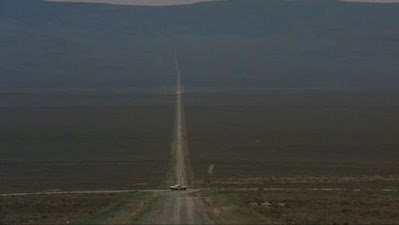Vanishing Point (Richard C. Sarafian, 1971) I guess it depends on how much you like cars.
When I watched Vanishing Point, so many months ago, the sense of "underwhelment" was overwhelming. A cult film, it initially performed poorly at the box-office; some contend that it had a crucial few minutes cut out prior to its release.* But, when put on a double bill with the hit The French Connection, all of a sudden, people started to embrace it. It had "found" its audience.
Reading a lot of online reviews, I came across rather inarticulate generalizations—it was about speed, freedom, oppression of "the man" (the oppressed being represented by 70's stereotypes—it's own form of repression), but mostly about cars...specifically, a 1970 Dodge Challenger R/T V-8 (440 "cubes"). If you're someone who can immediately picture that in your mind or recall the feel of driving one, opening it up on long stretches of highway, and that rev's you up, it's your kind of film.
In the driver's seat is Kowalski (Barry Newman), a car delivery driver being pursued by the California Highway Patrol. It's Sunday morning. On the road ahead, a roadblock has been set up to stop him—two bull-dozers have been angled to prevent him from getting anywhere past Cisco, California. He turns around, looking for a way to by-pass the block, but finds he's boxed in by three cop-cars farther up the road. Trapped. He pulls off the road and considers his options...then turns to face the bull-dozers. He accelerates, passing a black Chrysler Imperial (how'd it get there?) and the movie freezes and goes to flashback.
That Imperial could have been him on Friday. He pulled into Argo's Car Delivery Service in Denver, Colorado at 11:30pm, delivering a black Imperial he'd driven since San Francisco. There's a white Dodge Challenger that needs to be delivered to San Francisco on Monday and Kowalski insists on doing the job over the objections of his supervisor who thinks he should get some rest from the road. Ignoring that, and wanting to get back on the road, he takes the job and heads for a Denver biker bar where he gets a supply of speed and makes a bet with his dealer that he can make it back to San-Fran by 3:00 pm on Sunday (if all goes well).
It won't. His speeding gets the attention of the highway patrol, but he manages to evade his first encounter with them, but that incident and his triple-digit motoring has them strategizing how to stop him. That puts him on the radar on radio station KOW and its blind dj named Super Soul (Cleavon Little—was there anything he wasn't great in?), who monitors the police frequencies and relays their plans over the airwaves—convenient for Kowalski, who has been listening to KOW on the entire trip. Super Soul's ecstatic chronicling of the Challenger's race** makes Kowalski a folk-hero, drawing crowds to the station and angering the law. The disc jockey's seemingly omniscient patter must surely have influenced George Lucas—who was a gear-head and who probably saw the movie—to incorporate an "Oz"-like disk jockey (played by Wolfman Jack) in American Graffiti.
For a guy in a hurry, Kowalski has a lot of diversions, slowing his time, including blown tires, hitch-hikers, snake-catchers, Pentecostals, a pointlessly nude cycling hippie chick, and a healthy dose of distracting flashbacks about his past as a police officer (irony!), and a failed career as a stockcar and motorcycle racer. Kowalski may be "the last American hero" to Super Soul, but my opinion is reflective of a headline for a review of the 1925 version of Lord Jim (which I found researching the 1965 version): "Stupid White Man Makes Bad Choices." The movie tries so hard to be edgy and "with-it" that it has Kowalski have an encounter with "Death" (Charlotte Rampling), a scene that was cut out of the original release. Heavy, dude.
It should feel like Hemingway-esque existentialism but instead feels like "Having a Bad Day" nihilism (that is if the nihilism had a point) with nothing to show for it at the end. Hell, Kowalski doesn't even win the bet! And although it's a tale told not by idiots—that Black Imperial segue at the beginning is a pretty nifty idea—it is "full of sound and fury, signifying nothing." And not even the nihilistic kind of "nothing." Just nothing, null set, fade to black. "Wow, dude." The guy...and the movie...shoulda taken that right turn at Albuquerque.
* The version I saw was the complete version, with the supposedly crucial scene of Charlotte Rampling in it. All one can say is that there was no nirvana moment making me think that it was a masterpiece. The scene only made me think the movie was more pretentious than in its over-reaching than the shorter version was.
** "And there goes the Challenger, being chased by the blue, blue meanies on wheels. The vicious traffic squad cars are after our lone driver, the last American hero, the electric centaur, the, the demi-god, the super driver of the golden west! Two nasty Nazi cars are close behind the beautiful lone driver. The police numbers are gettin' closer, closer, closer to our soul hero, in his soul mobile, yeah baby! They about to strike. They gonna get him. Smash him. Rape... the last beautiful free soul on this planet."









No comments:
Post a Comment